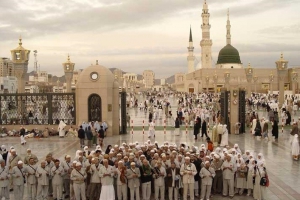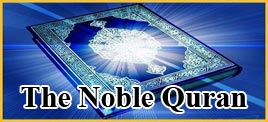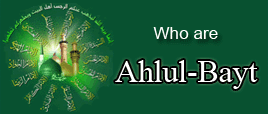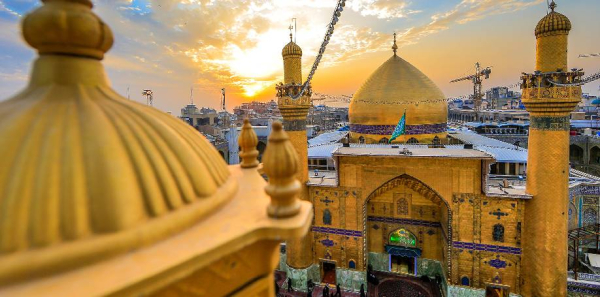Al-Masjid an-Nabawī, also called the Prophet's Mosque, is a mosque established and originally built by the Islamic prophet Mohammad (peace be upon him and his family), situated in the city of Medina in Arabia. Holy Prophet entered Yathrib on Friday. People were overjoyed and could not stop looking at the resplendent countenance of Mohammad, the Prophet of Islam (saw). Each tribe, which he passed through, desired the honor of his presence and requested him to take up his abode with them. Mohammad, the Prophet of Islam (saw), refusing all these offers, said that the camel, which he rode on, was inspired and would take him to the proper quarter. The camel proceeded on to the eastern sector and knelt down in the open courtyard of the Banu Najjar, near the house of Khalid ibn Zayd, known in history as Abu Ayyub al-Ansari, the then head of the Banu Najjar family. He was delighted to be fortunate to have the honor of Prophet Muhammad's (saw) presence.
Mohammad, the Prophet of Islam (saw) took up his temporary residence in the house of Abu Ayyub al-Ansari for seven months, until the Masjid, with proper quarters for himself, was built in the courtyard where the camel had stopped. The Prophet of Islam (saw) settled in Yathrib and there laid the foundations of Islam and a magnificent culture based on justice and faith.
After the blissful entrance of Mohammad, the Prophet of Islam (saw) into Yathrib, its name was changed into Medinat ul-Nabi, meaning 'the City of Mohammad, the Prophet of Islam (saw)'. That year, the year Mohammad, the Prophet of Islam (saw) migrated (Hijrah/Hijrat 622CE) at the age of 53 years from Makkah to Yathrib (Madinah), was recognized as the origin of history (beginning of the Islamic Era or the Hijrah calendar), due to this significant historical event, the triumph of righteousness and justice. The illuminating sun of Islam gave new life to the people. They discarded all the old superstitious beliefs and thoughts and all the wrong deeds and manners of the past, replacing them with the perfect life-giving culture of Islam.
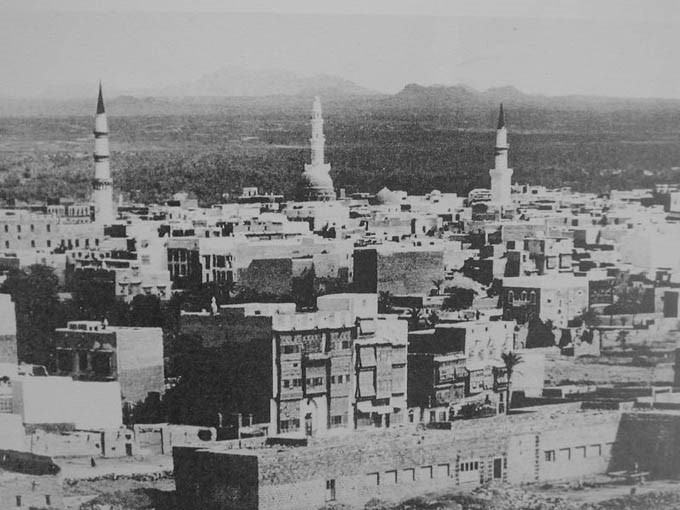
After the Battle of Khaybar, the mosque was "enlarged". The mosque extended for 47.32 meters (155.2 ft.) on each side and three rows of columns were built beside the west wall, which became the place of praying. The mosque remained unaltered during the reign of the first caliph Abu Baker. The second caliph Umar demolished all the houses around the mosque except that of Muhammad's wives to expand it. The new mosque's dimensions became 57.49 meters (188.6 ft.) × 66.14 meters (217.0 ft.). Sun-dried mud bricks were used to construct the walls of the enclosure. Besides strewing pebbles on the floor, the roof's height was increased to 5.6 meters (18 ft.). Umar moreover constructed three more gates for entrance.
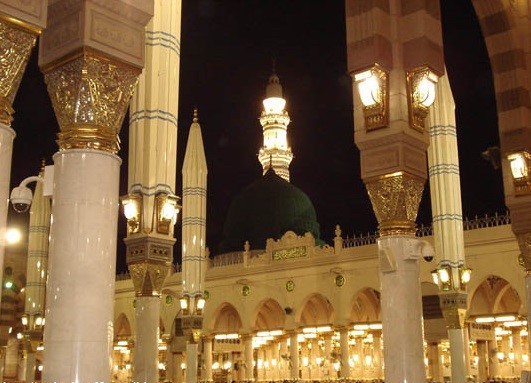
Middle years
In 707, Umayyad caliph Al-Walid ibn Abd al-Malik renovated the mosque. It took three years for the work to be completed. Raw materials were procured from the Byzantine Empire. The area of the mosque was increased from 5094 sq. meter of Uthman's time to 8672 sq. meter. A wall was built to segregate the mosque and the houses of the wives of Muhammad. The mosque was reconstructed in a trapezoid shape with a length of 101.76 meters (333.9 ft.). For the first time, porticoes were built in the mosque connecting the northern part of the structure to the sanctuary. For the first time, minarets were built in Medina as he constructed four minarets around it.
Abbasid caliph Al-Mahdi extended the mosque to the north by 50 meters (160 ft.). His name was also inscribed on the walls of the mosque. He also planned to remove six steps to the minbar, but abandoned this idea, owing to this causing damage of the woods on which they were built. According to an inscription of Ibn Qutaybah, the third caliph Al-Mamun did "unspecified work" on the mosque. Al-Mutawakkil lined the enclosure of Muhammad's tomb with marble. Al-Ashraf Qansuh al-Ghawri built a dome of stone over his grave in 1476.
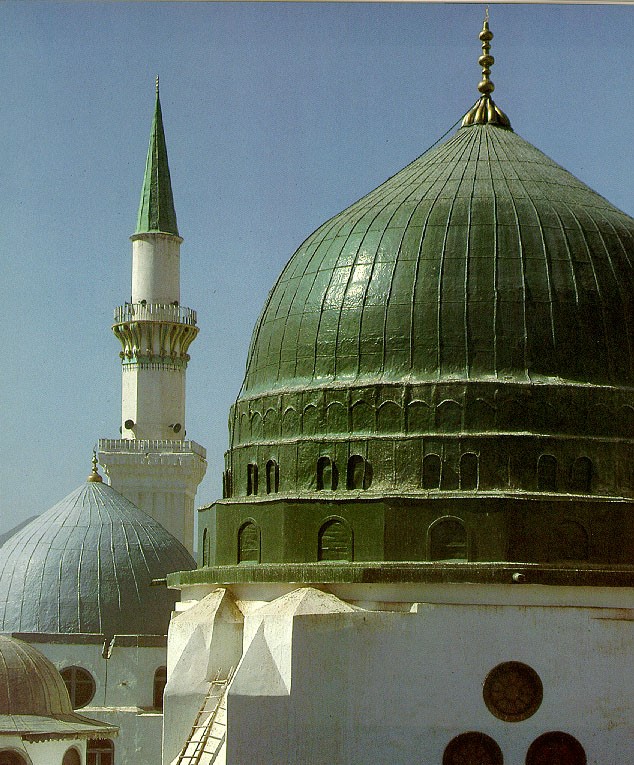
The Rawdah (referred to as al-Rawdah al-Mutaharah), covered by the dome over the south-east corner of the mosque, was constructed in 1817C.E. during the reign of Sultan Mahmud II. The dome was painted green in 1837 C.E. and came to be known as the "Green Dome".
The Sultan Abdul Majid I took thirteen years to rebuild the mosque, which started in 1849.[18] Red stone bricks were used as the main material in reconstruction of the mosque. The floor area of the mosque was increased by 1293 square meter. On the walls, verses from the Quran were inscribed in Islamic calligraphy. In the northern side of the mosque, a madrasah was built for "teaching Quranic lessons".
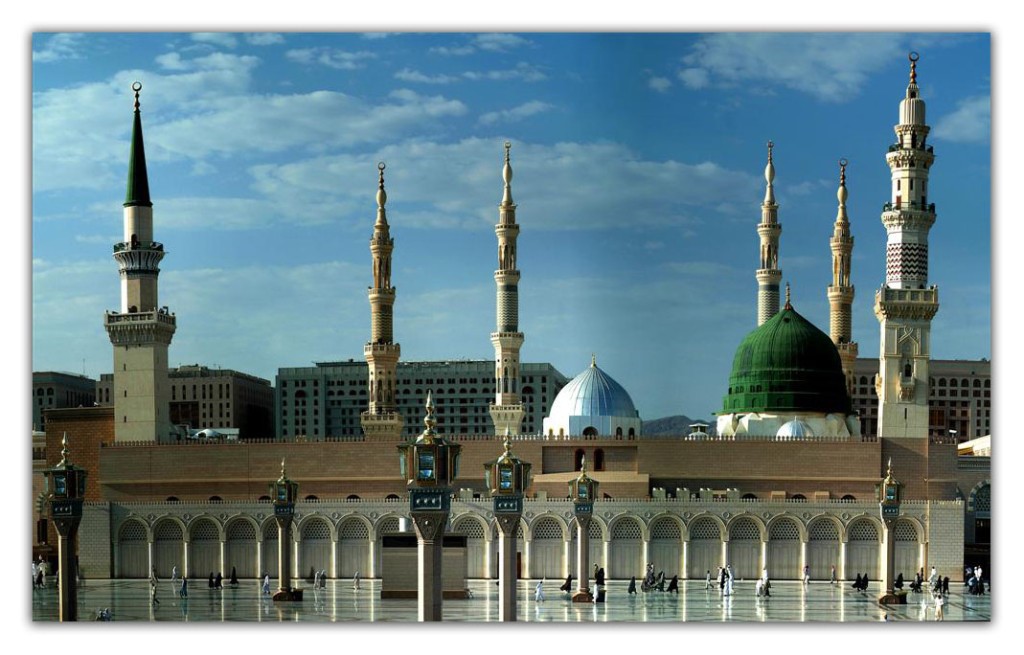
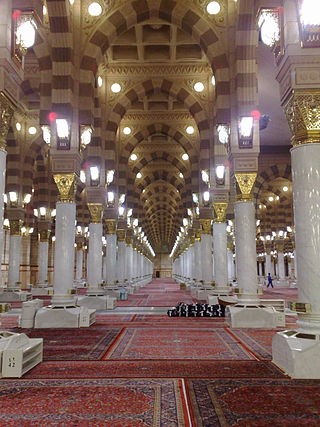
After the foundation of the Kingdom of Saudi Arabia in 1932, the mosque underwent several major modifications. In 1951 King Ibn Saud (1932–1953) ordered demolitions around the mosque to make way for new wings to the east and west of the prayer hall, which consisted of concrete columns with pointed arches. Older columns were reinforced with concrete and braced with copper rings at the top. The Suleymaniyya and Majidiyya minarets were replaced by two minarets in Mamluk revival style. Two additional minarets were erected to the northeast and northwest of the mosque. A library was built along the western wall to house historic Qurans and other religious texts.
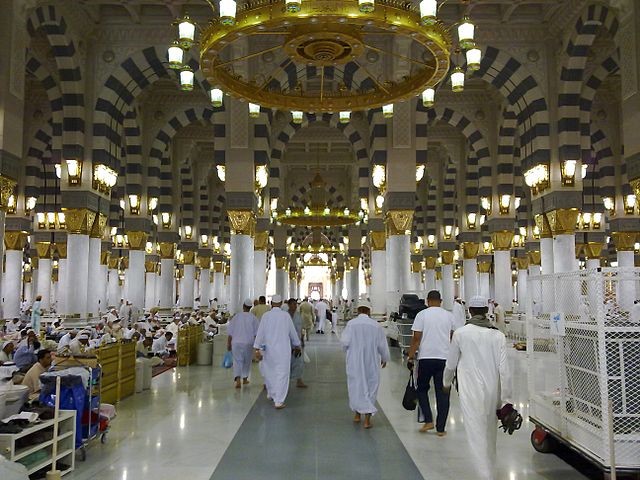
In 1974, King Faisal added 40,440 square meters to the mosque. The area of the mosque was also expanded during the reign of King Fahd in 1985. Bulldozers were used to demolish buildings around the mosque. In 1992, when it was completed, the area of the mosque became 1.7 million square feet. Escalators, 27 courtyards were amongst the additions to the mosque.
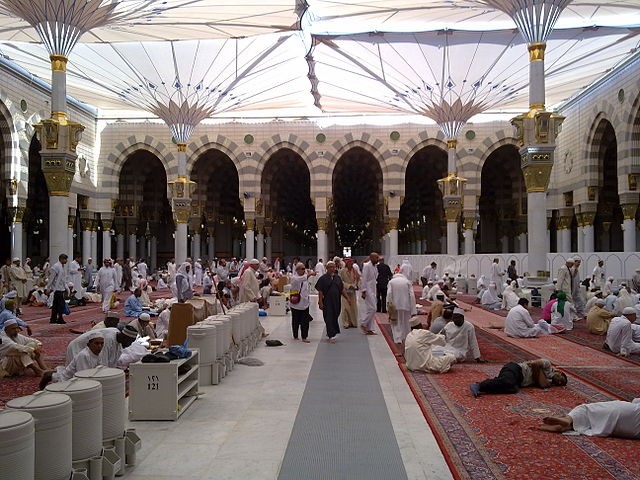
A $6 billion project for increasing the area of the mosque was announced in September 2012. It has reported that after the end of the work, it would accommodate 1.6 million people. In March of the following year, Saudi Gazette wrote "95 percent of the demolition work has been completed. About 10 hotels to the eastern side of the expansion were leveled to the ground in addition to a number of houses and other utilities to make way for the expansion."
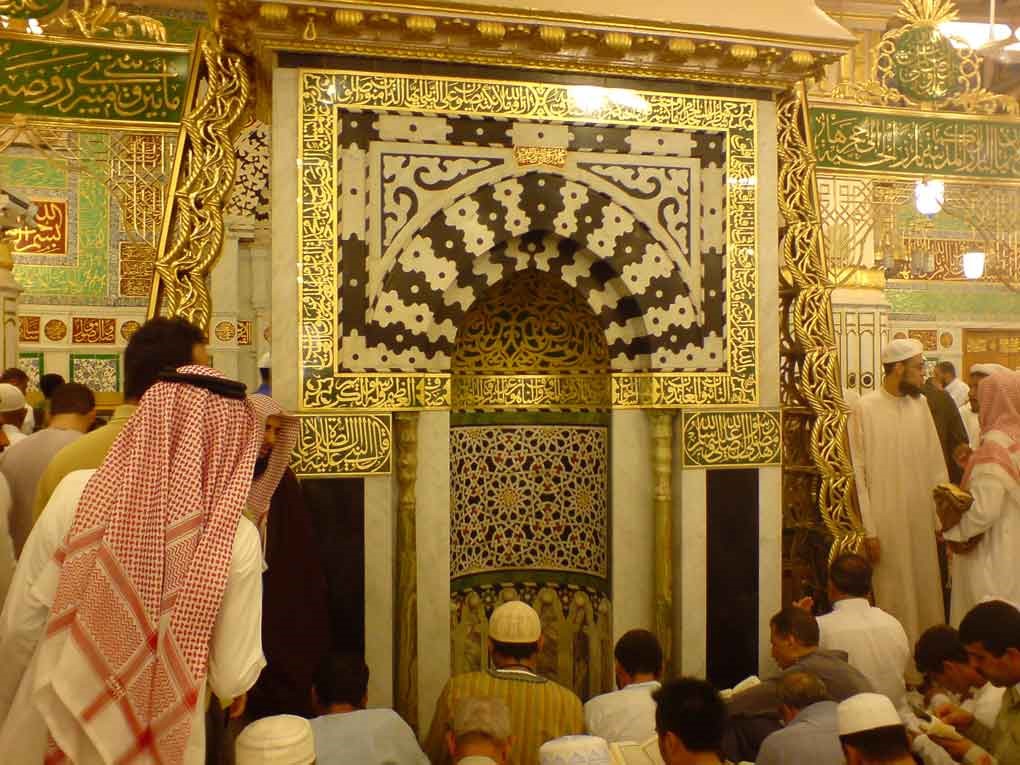
Riad ul-Jannah
The heart of the mosque houses a very special but small area named Riad ul-Jannah (Gardens of Paradise). It extends from Muhammad's tomb (Rawdah) to his pulpit (minbar). Pilgrims attempt to visit the confines of the area, for there is a tradition that supplications and prayers uttered here are never rejected. Entrance into the area is not always possible, especially during the Hajj season, as the space can only accommodate a few hundred people.
Riad ul-Jannah is considered to be a part Jannah (Paradise). It was narrated from Moavieh ben vahab from Imam Jafar Sadeq( peace be upon him) and Abu Hurayrah that Muhammad (PBUH)said, "The area between my house and my minbar is one of the gardens of Paradise, and my minbar is on my cistern (hawd)." Rawdah is floored with Green Carpet just to identify it, and the entire Mosque is floored with red carpet.
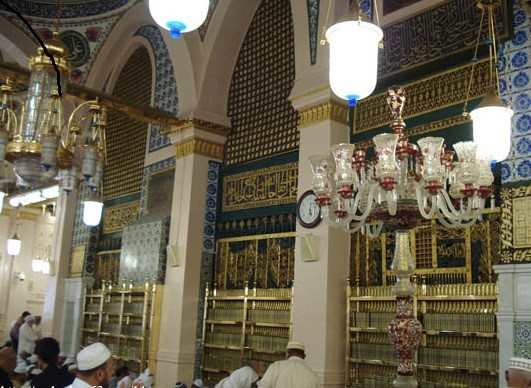
Mihrab
There are two mihrabs in the mosque, one was built by Mohammad (saw). The one built by the latter was larger than that of Muhammad’s (saw) and act as the functional mihrab, whereas Muhammad’s (saw) mihrab is a "commemorative" mihrab. Besides the mihrab, the mosque also has other niches which act as indicators for praying. This include mihrab al-tahajjud which was built by Muhammad for the tahajjud, mihrab Fatima.
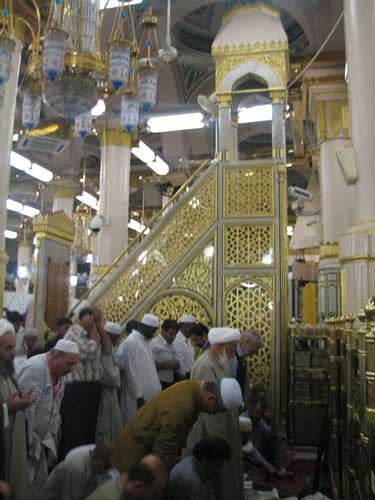
Minbar
When addressing the people in the mosque, the Prophet used to lean on large wood block of date tree. Later, when some difficulties arose in terms of people hearing and seeing the Prophet, a minbar made up of tamarisk, which was one-meter high with the dimensions of 50 x125 cm and a three-stair ladder located on three columns behind, was built in the year 7 (628) or 8 (629). This first minbar was used until 654 (1256), when it was ruined by a fire; a new minbar was placed which was sent by the king of Yemen, al-Malik al-Muzaffar Shamsuddin in 656 (1258). After this, the minbar was either replaced or removed in 666 (1268) by Sultan Baybars I, in 797 (1395) by the Mamluki Sultan Barkuk, and in 820 (1417) by another Mamluki Sultan Sheikh al-Mahmudi. In 886 (1481) the minbar was once more ruined by a fire, and a new minbar made up of brick plaster was built, which was later replaced by a marble minbar sent by Sultan Kayitbay in 888 (1483). This minbar was re-located to the Quba masjid in 998 (1590) when the Ottoman Sultan Murad III sent a marble minbar manufactured and ornamented in Istanbul, to replace it. This last minbar still stands in the Mosque of the Prophet today.
House of Hazrat Fatemeh Zahra (AS)
It is reported that the house of Fatima al Zahra(peace be upon her) is in masijdol nabi, but we are not sure about her grave and we do not know about its place, because she was annoyed by some people and testated Ali ibn Abitalib (peace be upon him) to bury her secretly.
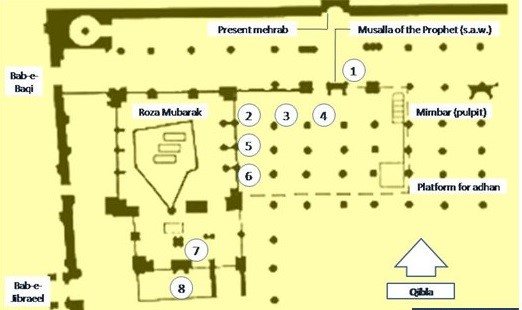
Major pillars of Masjid-e-Nabwi
The diagram above is a plan view of the front part of Masjid Nabwi and identifies pillars (ustuwaanah) where a significant event or act occurred (the pillars themselves are not important). Note that the position of these pillars was the same as in the time of the Prophet (peace and blessings of Allah be on him).
1. Ustuwaanah Hannanah (the weeping pillar):
This is also called the Ustuwaanah Mukhallaq. This is the most blessed of the pillars for this was the Prophet’s (peace and blessings of Allah be on him) place of salah. On this spot there once used to grow a date palm tree. Before the advent of the mimbar, the Prophet (peace and blessings of Allah be on him) used to lean on it while delivering the khutbah (sermon). When the mimbar was made the Prophet (peace and blessings of Allah be on him) used it for the khutbah. It so happened when the change took place, such a bitter sound of weeping was heard from the tree that the whole masjid echoed; and those in the masjid started weeping. The Prophet (peace and blessings of Allah be on him) then said: “The tree cries because the zikr of Allah was near it, and now that the mimbar is built it has been deprived of this zikr in its immediate vicinity. If I did not place my hand on it, it would have cried thus till the Day of Qiyamah.” Afterwards the tree dried up and was buried.
2. Ustuwaanah Sareer:
‘Sareer’ means sleeping place. It is reported that the Prophet (peace and blessings of Allah be on him) used to make i’tikaaf here also, and used to sleep here while in i’tikaaf. A platform of wood used to be put here for him to sleep on.
3. Ustuwaanah Tawbah
Also known as Ustuwaanah Abu Lubabah. Abu Lubabah (may Allah be pleased with him) was one of the famous Sahaba. Before Islam, he had much dealings with the Jews of Banu Quraizah. When they acted treacherously during the Battle of the Trench and were taken captive he told them that they were to be killed by making a sign across his throat. After having done that he become so grieved at this indiscretion that he could not rest.
He entered the masjid at this spot where a date-tree used to stand. He bound himself to the trunk saying: “As long as my repentance is not accepted by Allah, I shall not untie myself from here. And the Prophet (peace and blessings of Allah be on him) himself must undo my bonds.” When the Prophet (peace and blessings of Allah be on him) heard this he said: “If he had come to me I would have begged forgiveness on his behalf. Now he had acted on his own initiative, I cannot untie him until his repentance has been accepted.”
For many days he remained tied there, except for salah and the call of nature. At such times his wife and daughter used to untie him and then again tied him to the tree. He remained without food and drink as a result of which his sight and hearing were affected. Then after a few days one morning while the Prophet (peace and blessings of Allah be on him) was in tahajjud prayer in the house of Umme Salamah (may Allah be pleased with him), he received the good news that his tawbah had been accepted. The Sahabah (may Allah be pleased with him) conveyed the news to him, and wanted to untie him but he refused, saying: “As long as the Prophet (peace and blessings of Allah be on him) does not untie me with his blessed hands, I shall not allow anyone else to do so.” When the Prophet (peace and blessings of Allah be on him) entered for Fajr salah he untied him.
4. Ustuwaanah Aisha :
The Prophet (peace and blessings of Allah be on him) used to say his prayers here and afterwards moved to the place at Ustuwaanah Hannanah. It is also called the Ustuwaanah Qu’rah. The reason for this is that Aisha (may Allah be pleased with her) reports that the Prophet (peace and blessings of Allah be on him) said: “In this masjid is one such spot that if people knew the true blessed nature thereof, they would flock towards it in such in a manner to pray there they would have to cast such lots (i.e. Qu’rah).”
People asked her to point out the exact spot which she refused to do. Later on, at the persistence of Abdullah bin Zubair (may Allah be pleased with him) she pointed to this spot. Hence it is called Ustuwaanah Aisha, because the Hadith is reported by her and the exact spot was shown by her
5. Ustuwaanah Ali (p.b.u.h)
Also known as Ustuwaanah Mah’ras or Hars. ‘Hars’ means to watch or protect. This used to be the place where some of the Sahaba (may Allah be pleased with them) used to sit when keeping watch or acting as gatekeepers. Ali (may Allah rest his soul in peace) used to be the one who mostly acted as such, for which it is often called Ustuwaanah Ali (may Allah rest his soul in peace).
6. Ustuwaanah Wufood
‘Wufood’ means delegations. Whenever deputations arrived to meet the Prophet (peace and blessings of Allah be on him) on behalf of their tribes, they were seated here and here he used to meet them, conversed with them and taught them Islam.
7. Ustuwaanah Jibraeel
This was the usual place where Jibraeel (upon him be peace) used to enter to visit the Prophet (peace and blessings of Allah be on him). Today it cannot be seen as it lies inside the Sacred Chamber of the Prophet (peace and blessings of Allah be on him).
8. Ustuwaanah Tahajjud
It is reported that this was the spot where late at night a carpet was spread for the Prophet (peace and blessings of Allah be on him) to perform tahajjud prayer, after all the people had left.

